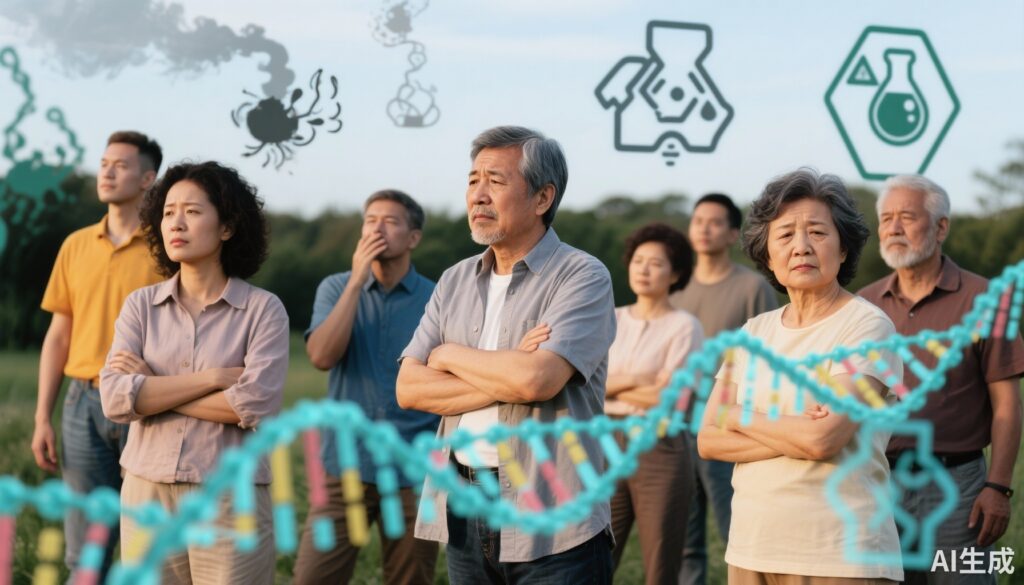Introduction: The Hidden Dimensions of Aging Beyond Chronological Years
Why do some people in their 50s appear vibrant and energetic while others of similar age look tired and aging prematurely? The answer extends far beyond natural wrinkles or skin blemishes. Accelerated biological aging reflects deeper physiological changes that elevate the risk of chronic diseases such as heart disease, cancer, and diabetes.
A landmark study by scientists at Stanford University has explored this perplexing issue by examining thousands of adults aged 50 to 84 to identify environmental chemical exposures that accelerate aging. Published in the journal Aging (Aging-US), their findings reveal surprising factors behind the speed at which our bodies grow older.
Decoding the Culprits Accelerating Aging: A Complex Challenge
Isolating the causes of aging acceleration amidst the countless chemical exposures humans face daily is daunting — akin to finding a needle in a haystack. Previous studies tackled individual offenders like lead, microplastics, or air pollution separately. However, this innovative research, led by Dr. Andres Cardenas, employed two novel scientific tools for a systemic environmental scan.
Tools of Discovery: The Exposome and Epigenetic Clocks
1. The Exposome: Mapping a Lifetime of Environmental Interactions
Imagine every environmental influence from conception to death — the air you breathe, the water you drink, your diet, consumer products you use, and even your social experiences. Together, they compose your “exposome.” If genetics represent a person’s “life book,” the exposome acts as principal editors and critics via epigenetics, determining how genes express themselves, which chapters are vividly read (active genes), and which are skipped (silenced). This epigenetic marking significantly influences aging speed.
Dr. Cardenas’s team used an exposome-wide association study (ExWAS) method analyzing blood and urine samples from participants, screening 64 common environmental chemicals for links to aging.
2. Epigenetic Clocks: Measuring Biological Age and Aging Speed
Traditional age reckoning is chronological — a date stamped on your birth certificate. But biological age, a better indicator of health, reflects our body’s real condition. Epigenetic clocks, groundbreaking tools measuring DNA methylation patterns, quantify biological age precisely.
These clocks fall into three generations:
– First-generation: Predict calendar age (useful in forensics).
– Second-generation: Predict health risks and mortality (like the GrimAge clock used here).
– Third-generation: Measure how fast one is currently aging (like the DunedinPACE clock), detecting real-time acceleration.
This study found that environmental impacts manifest more in mortality risk and aging pace, which second- and third-generation clocks detect.
Interestingly, among people aged 50 and above, biological aging speed showed little correlation with actual age. For instance, a 55-year-old might age rapidly biologically, whereas an 80-year-old could be aging more slowly, illustrating how accumulated health disparities and environment shape aging uniquely.
Revealing the Three Major Accelerators of Aging
After comprehensive analysis, three environmental factors stood out as key aging accelerators:
1. Smoking and Secondhand Smoke (Cotinine)
Cotinine, a metabolite of nicotine, effectively measures tobacco exposure. Higher cotinine levels in blood correlated with accelerated aging clocks, signifying increased death risk and faster biological aging.
Data showed that each standard deviation increase in blood cotinine accelerated GrimAge by approximately 1.40 years, meaning heavy smokers biologically age nearly 18 months more than non-smokers of the same age. Smoking also facilitates cadmium entry into lungs and bloodstream, compounding aging effects.
2. Cadmium: The Prime Heavy Metal Culprit
Of the 64 chemicals assessed, cadmium emerged as the strongest accelerator of biological aging. Increases in cadmium levels corresponded to significant jumps in GrimAge and DunedinPACE measures, indicating more rapid aging both short-term (blood exposure) and long-term (urine exposure).
Importantly, even when excluding smokers, cadmium’s impact remained significant, proving it as an independent aging accelerator primarily from:
– Occupational exposure (battery production, paint, electroplating).
– Environmental pollution near industrial zones.
– Dietary sources including rice, wheat, leafy vegetables, and bivalves like oysters.
Rather than avoiding these nutritious foods altogether, the study recommends dietary diversity and sourcing food from reputable, less polluted regions.
3. Lead: A Neurotoxin and Aging Accelerator
Lead exposure correlated with faster biological aging consistent across multiple epigenetic clocks. Historically noted for its harm to children and pregnant women, this study extends health concerns to adults, with each increase in blood lead accelerating GrimAge by around 0.7 years.
Although leaded gasoline and paint are largely phased out, legacy contamination persists in soil, old water pipes, and deteriorating paint in older neighborhoods, continuing to impact aging in adults.
Paradox of Toxic Chemicals That Seem to Slow Aging
Curiously, some potent toxins like dioxins and polychlorinated biphenyls (PCBs) were associated with slowed epigenetic aging. Researchers hypothesize these toxins may kill off malfunctioning aged white blood cells, prompting the body to produce new, younger immune cells in a stressed, emergency-like state. However, this apparent ‘rejuvenation’ is misleading, essentially a risky overextension that could jeopardize long-term health.
Pathways to Slower Aging: Diet, Environment, and Lifestyle
Not all news is bleak. The study found some dietary components, such as soy-derived equol and flavonoids from fruits and vegetables, linked to slower aging, although associations were weaker after adjusting for lifestyle factors.
Living in cleaner environments and making safer food choices related to decelerated biological aging, underscoring the power of environmental management.
Expert Insights: Taking Control of the Exposome to Delay Aging
Dr. Andres Cardenas emphasizes that genetic predisposition accounts for only a small fraction of chronic disease risk. Environmental factors play a far larger role, and managing one’s “exposome” offers a practical avenue for aging intervention.
Practical Steps for Healthy Aging
– Quit smoking immediately and avoid secondhand smoke: The most impactful intervention with benefits beyond any supplement.
– Eat smarter and drink cleaner: Use filters to reduce heavy metal ingestion from water and diversify your diet to avoid heavy metal accumulation.
– Choose safer living environments and food sources: Awareness of local pollution and sourcing foods from reputable regions can minimize toxic exposures.
Patient Scenario: John’s Journey to Healthy Aging
John, a 58-year-old former smoker living near an industrial area, noticed he felt fatigued despite his chronological age. After learning about his accelerated biological aging via an epigenetic test, he quit smoking, improved his diet with more plant-based foods, and installed a water filter. Over several years, he experienced increased energy, better health, and slowed aging markers.
John’s story underscores how informed lifestyle and environmental choices can meaningfully modulate aging.
Conclusion: Aging Is Not Destiny — It’s a Modifiable Journey
This groundbreaking study highlights smoking, cadmium, and lead as powerful catalysts of accelerated aging in adults over 50. By employing innovative exposome analysis and epigenetic clocks, scientists are redefining aging from a genetic fate to a pliable interplay between our environment, choices, and bodies.
Managing one’s environmental exposures represents a vital, evidence-based strategy to slow biological aging and reduce chronic disease risk. With awareness and action, aging can be a more graceful, healthier process rather than an inexorable decline.
References
[1] Khodasevich D, Gladish N, Daredia S, Bozack AK, Shen H, Nwanaji-Enwerem JC, Needham BL, Rehkopf DH, Cardenas A. Exposome-wide association study of environmental chemical exposures and epigenetic aging in the national health and nutrition examination survey. Aging (Albany NY). 2025 Feb 11;17(2):408-430. doi: 10.18632/aging.206201. Epub 2025 Feb 11. PMID: 39938123; PMCID: PMC11892924.
[2] Aging (Aging-US). (2025). Longevity & Aging Series (S3, E5): Dr. Andres Cardenas | Aging-US [Video]. YouTube. www.youtube.com/watch?v=A1I6qoVwkfM


